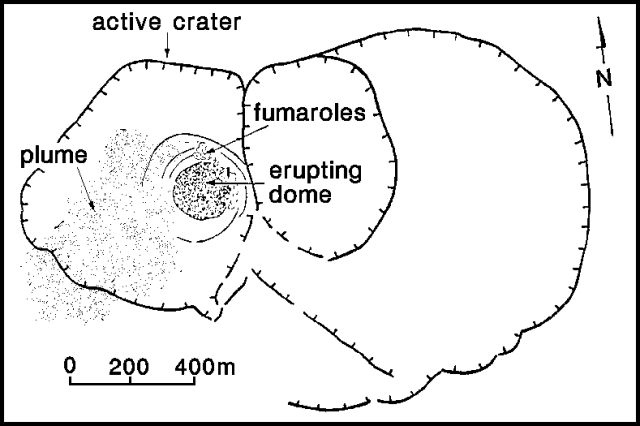Report on Lascar (Chile) — May 1992
Bulletin of the Global Volcanism Network, vol. 17, no. 5 (May 1992)
Managing Editor: Lindsay McClelland.
Lascar (Chile) New dome fills base of crater; occasional explosions
Please cite this report as:
Global Volcanism Program, 1992. Report on Lascar (Chile) (McClelland, L., ed.). Bulletin of the Global Volcanism Network, 17:5. Smithsonian Institution. https://doi.org/10.5479/si.GVP.BGVN199205-355100
Lascar
Chile
23.37°S, 67.73°W; summit elev. 5592 m
All times are local (unless otherwise noted)
On 4 March, a new lava dome was observed in the active crater . . . at the base of the S wall (17:3).
Following a request by local authorities (Intendencia and Oficina Regional de Emergencia, II Región), the Chilean Air Force overflew the volcano at 1245 on 20 March. The high-quality vertical photographs obtained of the summit area enabled an accurate estimation of the dome's size and volume. The dome appeared to fill the entire, nearly circular, base of the crater (180-190 m in diameter; figure 10), with a thickness of ~40 m, and an estimated volume of 1.1 x 106 m3. It had steep walls and was devoid of a talus apron. The blocky, rugged surface of the dome appeared to have formed as a smaller, black central elongated plug (85 x 115 m) intruded a dark-brownish older external rim. Strong fumarolic activity occurred along the NE edge of the dome, which strongly resembled the one observed in March and April 1989.
Observations from Talabre indicated that fumarolic activity had remained vigorous since late March, with eruption columns often 2-3 times larger than normal. The plume was usually yellowish to gray instead of its typical white until May, when a continuous dense gray plume was observed. Ashfall was reported on 15 May at 1050, accompanied by a gray eruption column estimated to be 1,500-2,000 m high (about 6x normal). On 21 May at 1130, an abrupt increase in the plume to a few kilometers height was observed by residents of nearby villages, and by people to 145 km W. The volcano "roared" for 10 minutes according to a witness (Luciano Sozo of Talabre) near the volcano. A second large explosion was reported that day at 1322 by Talabre residents. Following reports of night glow on 21-23 May, activity apparently returned to normal, with small pale-gray to white plumes and an absence of night glow. Although the May explosions were not as large as those in September 1986 and February 1990, scientists suggested that they might correspond to explosive destruction of part of the summit dome. Onset of winter and the partial covering of the cone by snow prevented visits to the summit, prompting a recommendation to the local authorities for new overflights and airphotos to monitor the development of the dome.
Several earthquakes recorded by the regional seismic network corresponded to large earthquakes centered away from the volcano, and were recorded by seismometers to the W. However, at least 4 small earthquakes were recorded between 24 April and late May only in villages closer to Lascar. The absence of seismometers near the volcano has prevented detailed monitoring of its seismicity.
Geological Summary. Láscar is the most active volcano of the northern Chilean Andes. The andesitic-to-dacitic stratovolcano contains six overlapping summit craters. Prominent lava flows descend its NW flanks. An older, higher stratovolcano 5 km E, Volcán Aguas Calientes, displays a well-developed summit crater and a probable Holocene lava flow near its summit (de Silva and Francis, 1991). Láscar consists of two major edifices; activity began at the eastern volcano and then shifted to the western cone. The largest eruption took place about 26,500 years ago, and following the eruption of the Tumbres scoria flow about 9000 years ago, activity shifted back to the eastern edifice, where three overlapping craters were formed. Frequent small-to-moderate explosive eruptions have been recorded since the mid-19th century, along with periodic larger eruptions that produced ashfall hundreds of kilometers away. The largest historical eruption took place in 1993, producing pyroclastic flows to 8.5 km NW of the summit and ashfall in Buenos Aires.
Information Contacts: M. Gardeweg, SERNAGEOMIN, Santiago.


